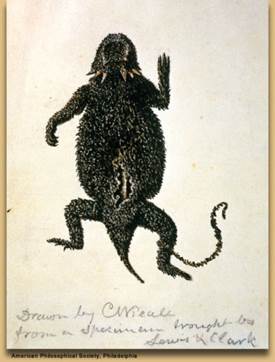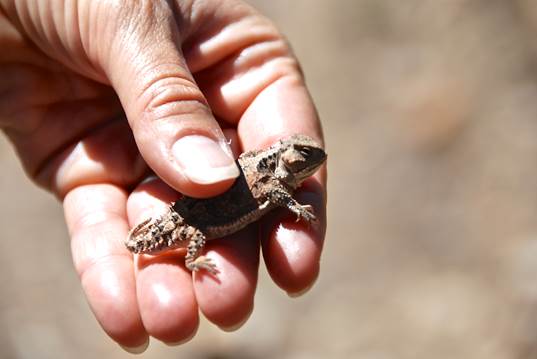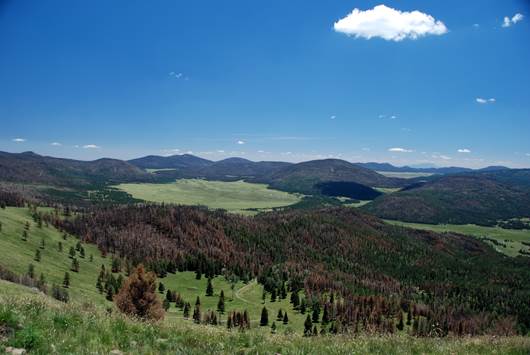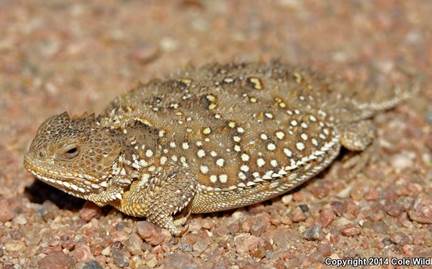Great horny toads!! — Yosemite Sam
Generally known as horned toads or horny toads, these are small, squat lizards that have short tails with spines on the head and fringed scales on the sides of the stomach. Nostrils are present in the front of a blunt snout – the tail is about one third of the length of the body. A single row of fringed scales is located on the lower side of the body. The color is a tawny brown with spots of gray of darker brown. An adult is about 2.4 – 3.7 inches in length and weighs about 1 ounce.
Phrynosoma– phrynos, Greek for toad and soama, Greek for body. The species name hernandesi, honors Francisco Hernandez Medico who described the horned toad in 1681 in Mexico.
The species has a wide range that extends from southern Canada through eastern Montana, the western Dakotas, Wyoming, western Nebraska, Colorado, Utah, eastern Nevada, New Mexico, Arizona, southern Idaho, and mountains of western Texas. It inhabits semi-arid plains and mountains and commonly is found in sparsely vegetated areas. When the lizard is not active on the surface it will use existing rodent-dug burrows or will bury itself into softer soils. It is generally found at higher elevations though it occurs at lower elevations as you move north.
Horned toads can tolerate cooler temperatures than most lizards and can be found above ground while others have retreated to the warmth of burrows. They usually disappear about the time of the median annual frost. It’s thought that these lizards clue in on a shorting day length as a trigger for when to head underground for the winter.
Horned toads are viviparous – they give birth to live young during the mid- to late-summer. Males are sexually mature in the summer following their first winter dormancy – it is not known if females follow a similar pattern. Mating occurs in the spring and gestation lasts about 3 months when the birth of 5-30 (!!!) young occurs. Females are known to live up to five years. The favorite food of horned toads is ants, though they will munch on beetles and other invertebrates opportunistically.
In 1997 a scientist examined the mitochondrial DNA in short-horned lizards throughout their range and determined that those in the Pacific Northwest are a different species – what is now called the pygmy short-horned lizard. There are a variety of other horned toad species and subspecies in North America. The horned frog (?) is the mascot of TCU, which had a pretty good football season this year. Why they call it the horned frog instead of horned toad – I have no idea.
When threatened by a canine (such as fox, coyote, or a dog) the greater short-horned lizard will increase the blood pressure in its eye, bursting capillaries around the eye and squirting a stream of blood towards its adversary. The premise is that the blood tastes awful to canines and they will back away from this tiny prey item. Here’s a short clip if you don’t mine the short commercial beforehand: http://www.discovery.com/tv-shows/other-shows/videos/nasty-by-nature-horned-lizard-blood-gun/

This drawing of a horned toad specimen provided by Lewis and Clark is listed as completed by C.W. Peale, who did many drawings of specimens from the expedition. But apparently it was really completed by Pietro Ancora, an Italian artist who immigrated to America in 1800. See the journal entry for May 29, 1806 that mentions the horned toad here:http://lewisandclarkjournals.unl.edu/read/?_xmlsrc=1806-05-29.xml&_xslsrc=LCstyles.xsl
I’ve run across the greater short-horned lizard in several places – the last was in the Valles Caldera National Preserve in New Mexico. It’s a 13-mile-wide caldera and reserve operated under a public-private partnership. Oddly, we were the only folks visiting the site besides a few fly-fishers in July. You can’t drive around the preserve yourself but they supply a van shuttle driven by one of the local Jemez Pueblo members. After getting dropped off we decided to head uphill on an old road that reached the rim of the caldera. On the way up I noticed a short-horned lizard scrambling by and just had to pick up the chubby little guy. Interestingly, they don’t use the blood squirting tactic when handled by humans. I was ok with that.


